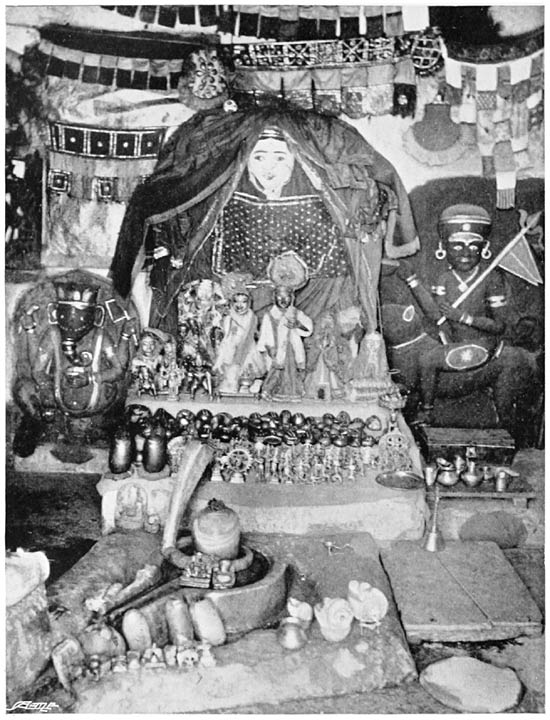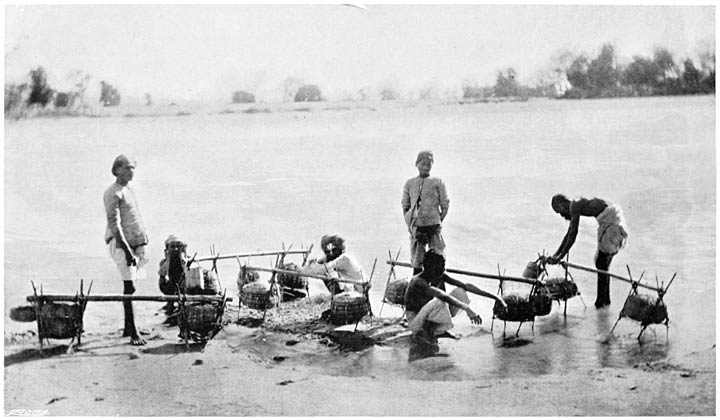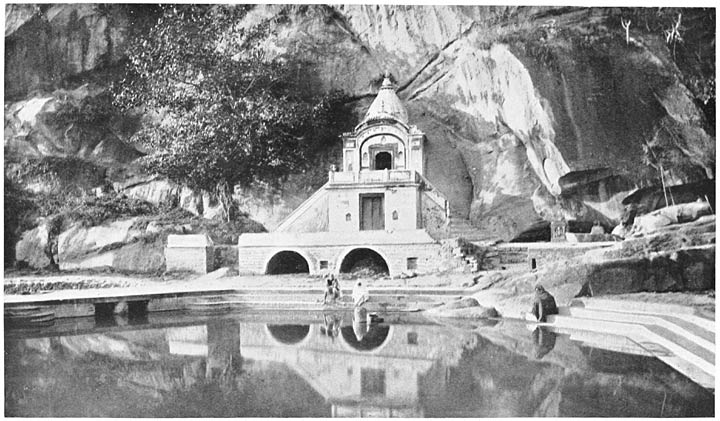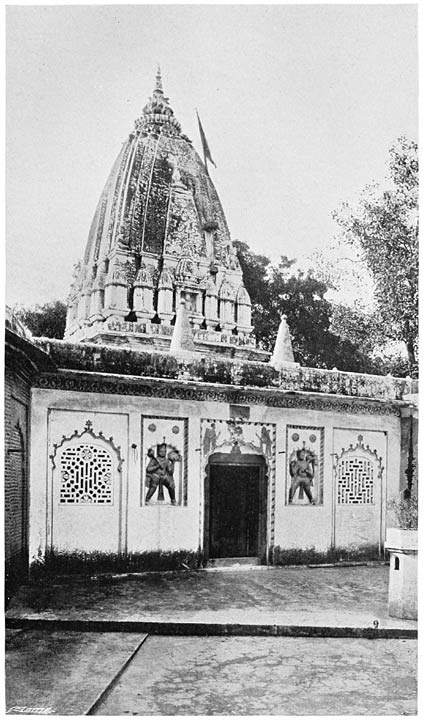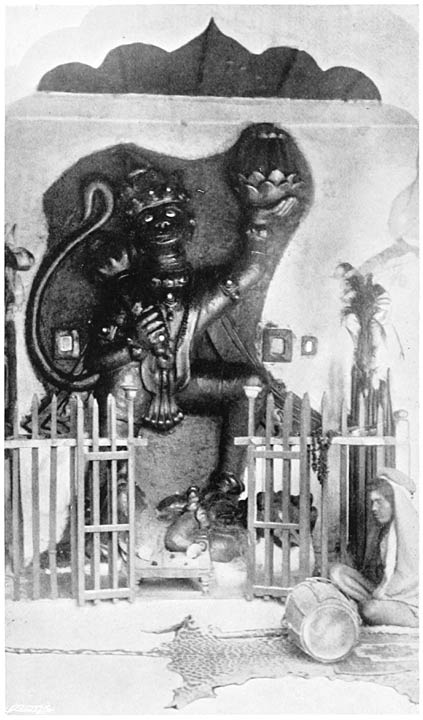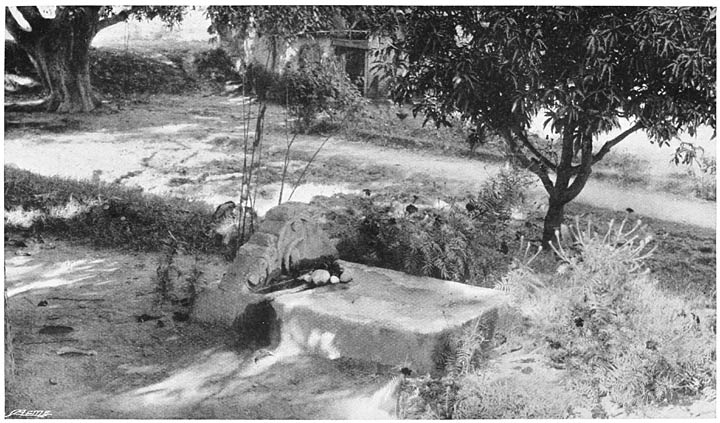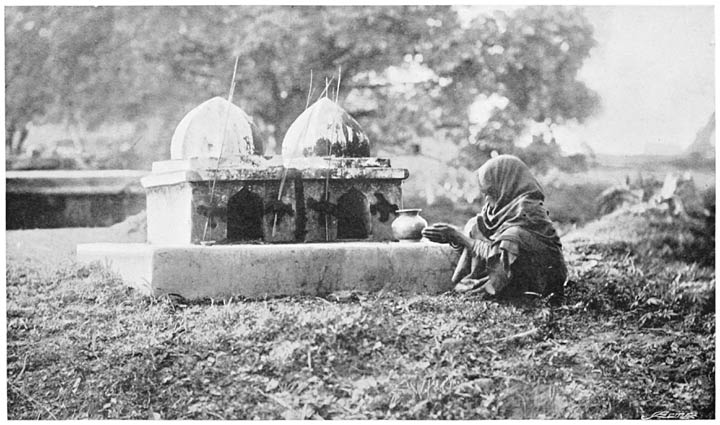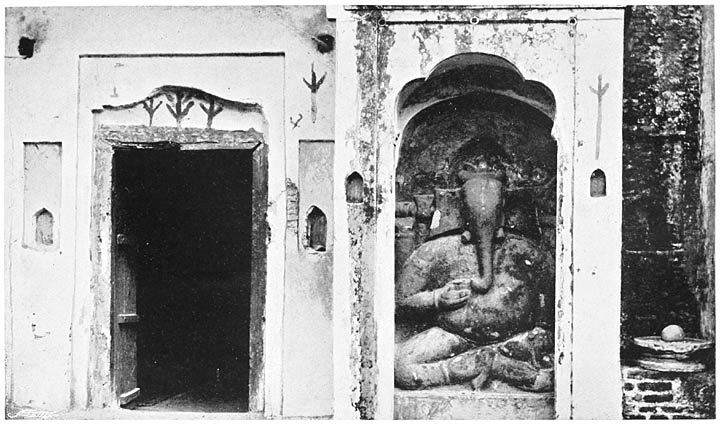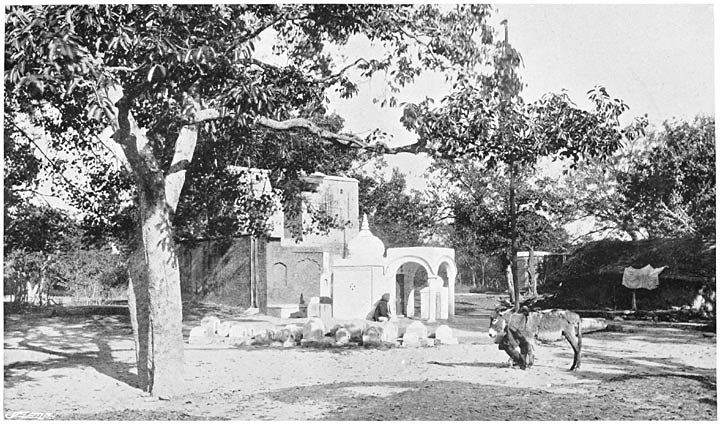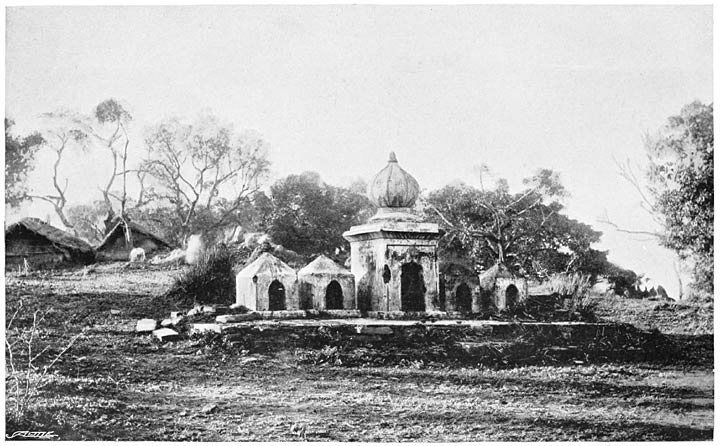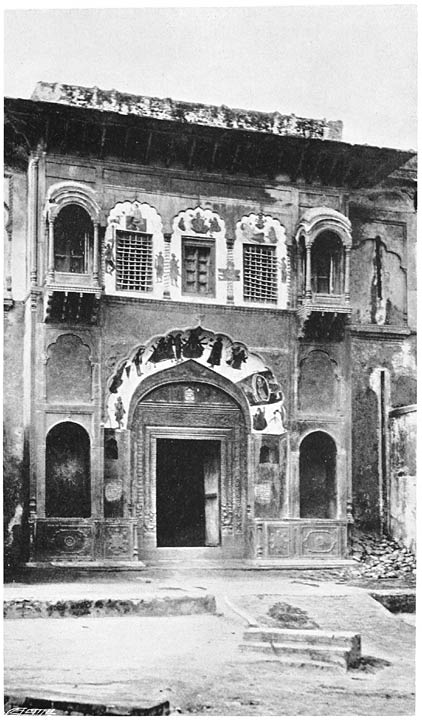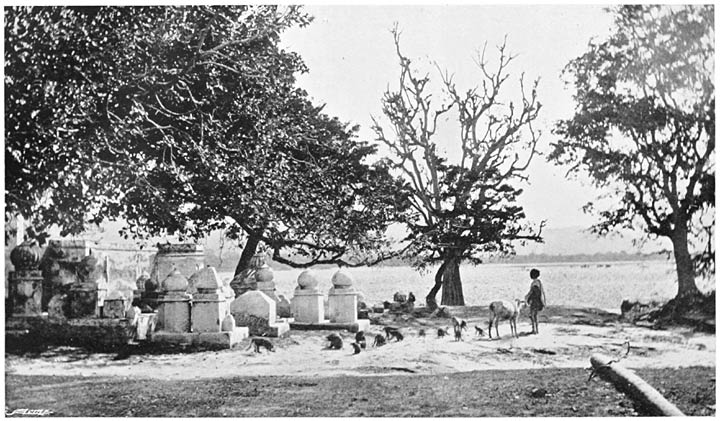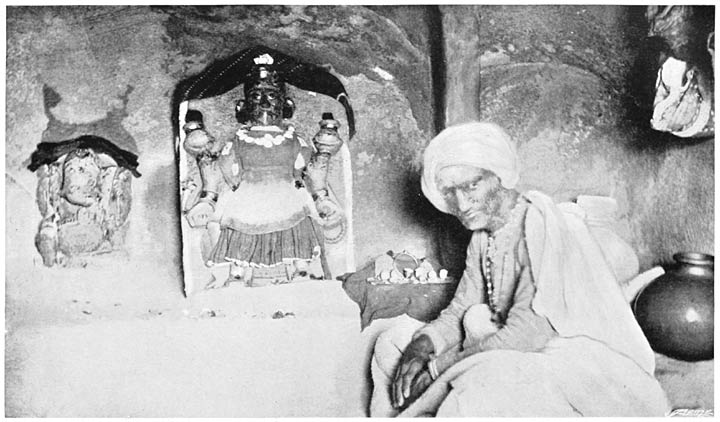To return to the use of the scape animal as a means of
expelling disease. In Berâr, if cholera is very severe, the
people get a scapegoat or young buffalo, but in either case it must be
a female and as black as possible, the latter condition being based on
the fact that Yamarâja, the lord of death, uses such an animal as
his vehicle. They then tie some grain, cloves and red lead (all demon
scarers) on its back and turn it out of the village. A man of the
gardener caste takes the goat outside the boundary, and it is not
allowed to return.74 So among the Korwas of
Mirzapur, when cholera begins, a black cock, and when it is severe, a
black goat, is offered by the Baiga at the shrine of the village
godling, and he then drives the animal off in the direction of some
other village. After it has gone a little distance, the Baiga, who is
protected from evil by virtue of his holy office, follows it, kills it
and eats it. Among the Patâris in cholera epidemics the elders of
the village and the Ojha wizard feed a black fowl with grain and drive
it beyond the boundary, ordering it to take the plague with it. If the
resident of another village finds such a fowl and eats it, cholera
comes with it into his village. Hence, when disease prevails, people
are very cautious about meddling with strange fowls. When these animals
are sent off, a little oil, red lead, and a woman’s forehead
spangle are put upon it, a decoration which, perhaps, points to a
survival of an actual sacrifice to appease the demon of disease. When
such an animal comes into a village, the Baiga takes it to the local
shrine, worships it and [170]then passes it on quietly outside
the boundary. Among the Kharwârs, when rinderpest attacks the
cattle, they take a black cock, put some red lead on its head, some
antimony on its eyes, a spangle on its forehead, and fixing a pewter
bangle to its leg, let it loose, calling to the
disease—“Mount on the fowl and go elsewhere into the
ravines and thickets; destroy the sin!” This dressing up of the
scape animal in a woman’s ornaments and trinkets is almost
certainly a relic of some grosser form of expiation in which a human
being was sacrificed. We have another survival of the same practice in
the Panjâb custom, which directs that when cholera prevails, a
man of the Chamâr or currier caste, one of the hereditary
menials, should be branded on the buttocks and turned out of the
village.75
A curious modification of the ordinary scape animal, of which it is
unnecessary to give any more instances, comes from Kulu.76 “The people occasionally perform an
expiatory ceremony with the object of removing ill-luck or evil
influence, which is supposed to be brooding over the hamlet. The
godling (Deota) of the place is, as usual, first consulted through his
disciple (Chela) and declares himself also under the influence of a
charm and advises a feast, which is given in the evening at the temple.
Next morning a man goes round from house to house, a creel on his back,
into which each family throws all sorts of odds and ends, parings of
nails, pinches of salt, bits of old iron, handfuls of grain, etc. The
whole community then turns out and perambulates the village, at the
same time stretching an unbroken thread round it, fastened to pegs at
the four corners. This done, the man with the creel carries it down to
the river bank and empties the contents therein, and a sheep, fowl, and
some small animals are sacrificed on the spot. Half the sheep is the
property of the man who dares to carry the creel, and he is also
entertained from house to house on the following night.”
It is obvious that this exactly corresponds with the old English
custom of sin-eating. Thus we read:77—“Within
[171]the memory of our fathers, in Shropshire, when a
person died, there was a notice given to an old sire (for so they
called him), who presently repaired to the place where the deceased
lay, and stood before the door of the house, when some of the family
came out and furnished him with a cricket on which he sat down facing
the door. Then they gave him a groat, which he put in his pocket; a
crust of bread, which he ate; and a full bowl of ale, which he drank
off at a draught. After this he got out from the cricket and
pronounced, with a composed gesture, the ease and rest of the soul
departed, for which he would pawn his own soul.”
There are other Indian customs based on the same principle.78 Thus, in the Ambâla District a
Brâhman named Nathu stated “that he had eaten food out of
the hand of the Râja of Bilâspur, after his death, and that
in consequence he had for the space of one year been placed on the
throne at Bilâspur. At the end of the year he had been given
presents, including a village, and had then been turned out of
Bilâspur territory and forbidden apparently to return. Now he is
an outcast among his co-religionists, as he has eaten food out of the
dead man’s hand.” So at the funeral ceremonies of the late
Rânî of Chamba, it is said that rice and ghi were placed in
the hands of the corpse, which a Brâhman consumed on payment of a
fee. The custom has given rise to a class of outcast Brâhmans in
the Hill States about Kângra. In another account of the funeral
rites of the Rânî of Chamba, it is added that after the
feeding of the Brâhman, as already described, “a stranger,
who had been caught beyond Chamba territory, was given the costly
wrappings round the corpse, a new bed and a change of raiment, and then
told to depart, and never to show his face in Chamba again.” At
the death of a respectable Hindu the clothes and other belongings of
the dead man are, in the same way, given to the Mahâbrâhman
or funeral priest. This seems to be partly based on the principle that
he, by using these articles, passes them on for the use of the deceased
in the land of death; but the detestation and contempt [172]felt
for this class of priest may be, to some extent, based on the idea that
by the use of these articles he takes upon his head the sins of the
dead man.79
Again, writing of the customs prevailing among the Râjput
tribes of Oudh which practise female infanticide, Gen. Sleeman
writes:80—“The infant is destroyed in the room
where it was born, and there buried. The room is then plastered over
with cow-dung, and on the thirteenth day after, the village or family
priest must cook and eat his food in this room. He is provided with
wood, ghi, barley, rice, and sesamum. He boils the rice, barley, and
sesamum in a brass vessel, throws the ghi over them when they are
dressed, and eats the whole. This is considered as a Homa or burnt
offering, and by eating it in that place, the priest is supposed to
take the whole Hatya or sin upon himself, and to cleanse the family
from it.”
So, in Central India the Gonds in November assemble at the shrine of
Gansyâm Deo to worship him. Sacrifices of fowls and spirits, or a
pig, occasionally, according to the size of the village, are offered,
and Gansyâm Deo is said to descend on the head of one of the
worshippers, who is suddenly seized with a kind of fit, and after
staggering about for a while, rushes off into the wildest jungles,
where the popular theory is that, if not pursued and brought back, he
would inevitably die of starvation, and become a raving lunatic. As it
is, after being brought back by one or two men, he does not recover his
senses for one or two days. The idea is that one man is thus singled
out as a scapegoat for the sins of the rest of the village.
In the final stage we find the scape animal merging into a regular
expiatory sacrifice. Other examples will be given in another connection
of the curious customs, like that of the Irish and Manxland rites of
hunting the wren, which are almost certainly based on the principle of
a sacrifice. Here it may be noted that at one of their festivals, the
Bhûmij [173]used to drive two male buffaloes into a small
enclosure, while the Râja and his suite used to witness the
proceedings. They first discharged arrows at the animals, and the
tormented and enraged beasts fell to and gored each other, while arrow
after arrow was discharged. When the animals were past doing very much
mischief, the people rushed in and hacked them to pieces with axes.
This custom is now discontinued.81
Similarly in the Hills, at the Nand Ashtamî, or feast in
honour of Nanda, the foster father of Krishna, a buffalo is specially
fed with sweetmeats, and, after being decked with a garland round the
neck, is worshipped. The headman of the village then lays a sword
across its neck and the beast is let loose, when all proceed to chase
it, pelt it with stones, and hack it with knives until it dies. It is
curious that this savage rite is carried out in connection with the
worship of the Krishna Cultus, in which blood sacrifice finds no
place.82
In the same part of the country the same rite is performed after a
death, on the analogy of the other instances, which have been already
quoted. When a man dies, his relations assemble at the end of the year
in which the death occurred, and the nearest male relative dances naked
(another instance of the nudity charm, to which reference has been
already made) with a drawn sword in his hand, to the music of a drum,
in which he is assisted by others for a whole day and night. The
following day a buffalo is brought and made intoxicated with Bhang or
Indian hemp, and spirits, and beaten to death with sticks, stones and
weapons.
So, the Hill Bhotiyas have a feast in honour of the village god, and
towards evening they take a dog, make him drunk with spirits and hemp,
and kill him with sticks and stones, in the belief that no disease or
misfortune will visit the village during the year.83 At the
periodical feast in honour of the mountain goddess of the
Himâlaya, Nandâ Devî, it is said that a four-horned
goat is invariably born and accompanies the pilgrims. When unloosed on
the mountain, the [174]sacred goat suddenly disappears and as
suddenly reappears without its head, and then furnishes food for the
party. The head is supposed to be consumed by the goddess herself, who
by accepting it with its load of sin, washes away the transgressions of
her votaries. [175]



